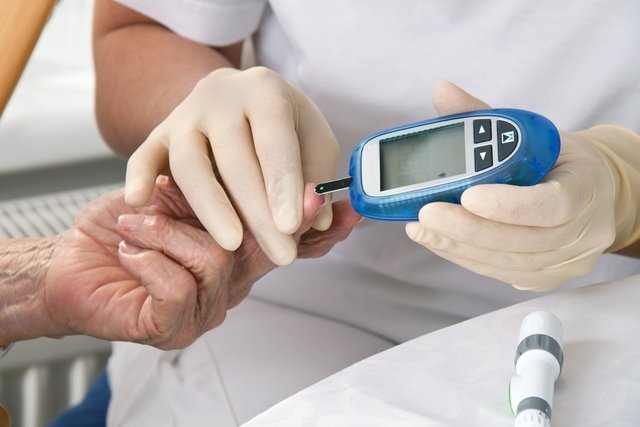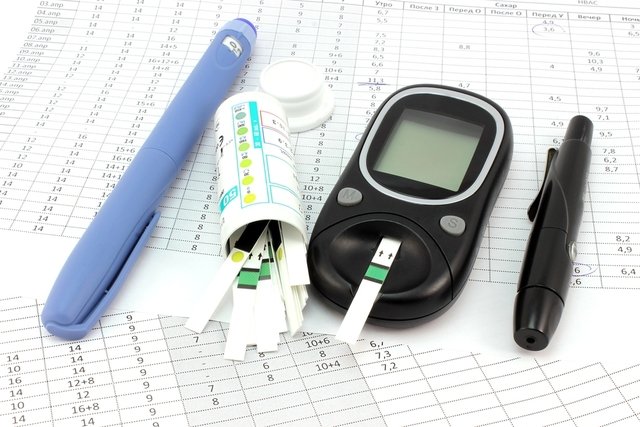Diabetes complications usually arise when treatment is not carried out correctly and when sugar levels are not controlled, as excess sugar can cause damage throughout the body, including eyes, kidneys, blood vessels, heart and nerves. , which can result in hypo or hyperglycemia, kidney changes, eye problems, increased risk of infection and difficulty healing wounds.
However, the complications of diabetes can be easily avoided by taking medication or insulin recommended by the endocrinologist, controlling blood glucose throughout the day, practicing physical activity regularly and eating a healthy and balanced diet, in accordance with the guidelines. nutritionist’s recommendations.

Main complications
Some of the main complications related to uncontrolled diabetes are:
1. Hypoglycemia
Hypoglycemia is an acute complication of diabetes and can occur when treatment is not carried out correctly, that is, when the person uses a greater amount of insulin or medication than recommended by the doctor, which can cause the sugar level drops considerably, possibly falling below 70 mg/dL. Symptoms of hypoglycemia may vary from one person to another, but the most common are nausea, dizziness, tremors and cold sweat. Know how to recognize the symptoms of hypoglycemia.
2. Hyperglycemia
Hyperglycemia is a complication of diabetes that can occur when treatment is not carried out, so that the sugar level remains high throughout the day, resulting in symptoms such as blurred and blurred vision, thirst, dry skin and weakness. If hyperglycemia is persistent, it may result in some situations:
- Diabetic ketoacidosis: is a situation that occurs as a consequence of insulin deficit, being characterized by a glucose level above 300 mg/dL and an increase in the amount of circulating ketone bodies, resulting in symptoms such as intense thirst, bad breath, abdominal pain, rapid breathing and mental confusion;
- Non-ketotic hyperosmolar syndrome or non-ketotic hyperosmolar coma: It happens when blood glucose is above 600 mg/dL, being more common in older people, and resulting in deterioration of the central nervous system and severe dehydration.
To prevent these situations, it is important to carry out treatment as directed by your doctor and measure your glucose levels regularly, several times a day, and it is important to go to the emergency room or nearest hospital when your blood glucose is very high.
3. Diabetic foot
Diabetic foot is one of the most common complications of diabetes and is characterized by the appearance of wounds on the skin and lack of sensation in the foot, which occurs due to injuries to blood vessels and nerves, and in very serious cases, amputation may be necessary. of the affected limb, as circulation is compromised.
To treat this problem, it is necessary to apply bandages at the medical center and it is important to wash and dry your feet daily and apply moisturizing cream, especially on the heels. See more about how to identify and treat diabetic foot.
4. Kidney injuries
Kidney damage, also known as diabetic nephropathy, is a change in the blood vessels of the kidneys that lead to difficulties in filtering the blood, which can result in kidney failure and the need for hemodialysis, which consists of a procedure in which the Kidney function is replaced by a machine, with filtration.
A sign that indicates the occurrence of nephropathy is the presence of albumin in the urine and, the greater the amount of albumin in the urine, the more serious the state of nephropathy. Learn more about diabetic nephropathy.
5. Eye problems
Changes in vision can also be caused by excessive amounts of sugar circulating in the blood, with a greater risk of:
- waterfalls in which an opacity forms in the lens of the eye, leaving vision blurred;
- Glaucoma which is damage to the optic nerve, which can lead to loss of the visual field;
- Edema macular in which there is deposition and accumulation of fluids and proteins in the macula of the eye, which is the central region of the retina, making it thicker and swollen;
- Diabetic retinopathy in which damage occurs to the blood vessels in the retina of the eyes, which can cause permanent blindness. Learn more about diabetic retinopathy.
If the patient experiences blurred or unfocused vision, they should go to the ophthalmologist and once diabetic retinopathy is detected, treatment can be carried out through laser photocoagulation, surgery or intraocular injections.
6. Diabetic neuropathy
Diabetic neuropathy is the progressive degeneration of nerves, which causes decreased sensitivity in some parts of the body, such as the feet, causing diabetic feet or a burning, cold or tingling sensation in the affected limbs. See how to treat diabetic neuropathy.
7. Heart problems
Uncontrolled diabetes can also favor the development of various inflammatory processes in the body, increasing the risk of heart damage. Therefore, there is a greater possibility of a person having a heart attack, increased blood pressure or a stroke.
In addition, there is also a greater risk of peripheral vascular disease, in which the arteries in the legs and feet suffer obstruction or occlusion, which leads to narrowing and hardening of the arteries.
8. Infections
People with diabetes have a greater chance of developing infections because there is always a large amount of sugar circulating in the blood, which favors the proliferation of microorganisms and the development of infection. Furthermore, large amounts of circulating sugar can directly interfere with immunity.
Thus, in the case of uncontrolled diabetes there is a greater risk of infections and the development of periodontal diseases, in which there is infection and inflammation of the gums that can lead to tooth loss.
Complications of gestational diabetes
Complications of gestational diabetes arise during pregnancy and can be:
- Excessive growth of the fetus which can result in birth complications;
- Development of diabetes in the future;
- Higher risk of miscarriage or the baby dies shortly afterwards;
- Low blood sugar or another illness in the newborn, as after birth the baby no longer receives glucose from the mother;
To prevent these complications, it is important to detect the disease early by carrying out several tests of blood and urine sugar levels, and this is done during regular surveillance appointments throughout the pregnancy.

Sign up for our newsletter and stay up to date with exclusive news
that can transform your routine!
Warning: Undefined array key "title" in /home/storelat/public_html/wp-content/plugins/link-whisper-premium/templates/frontend/related-posts.php on line 12
Warning: Undefined array key "title_tag" in /home/storelat/public_html/wp-content/plugins/link-whisper-premium/templates/frontend/related-posts.php on line 13




